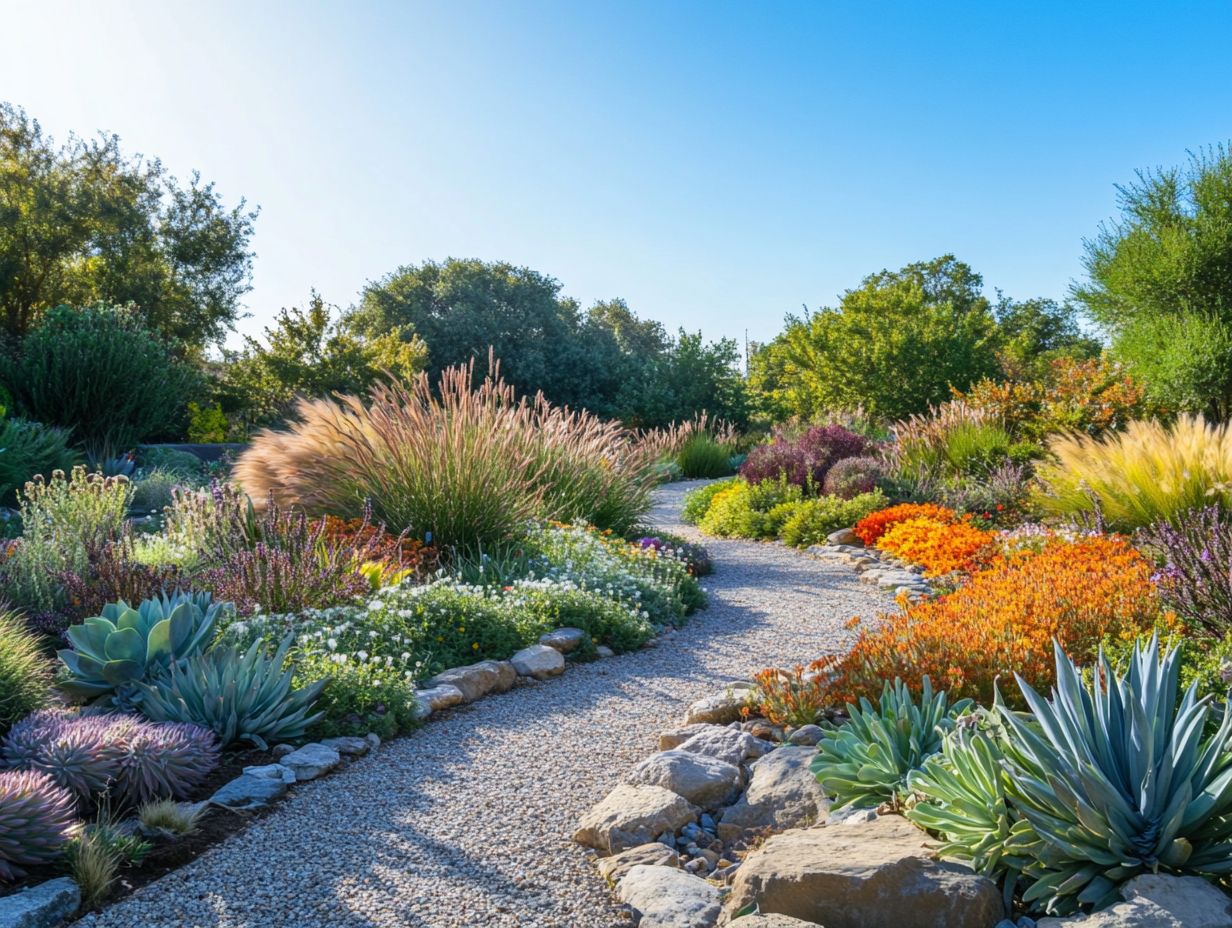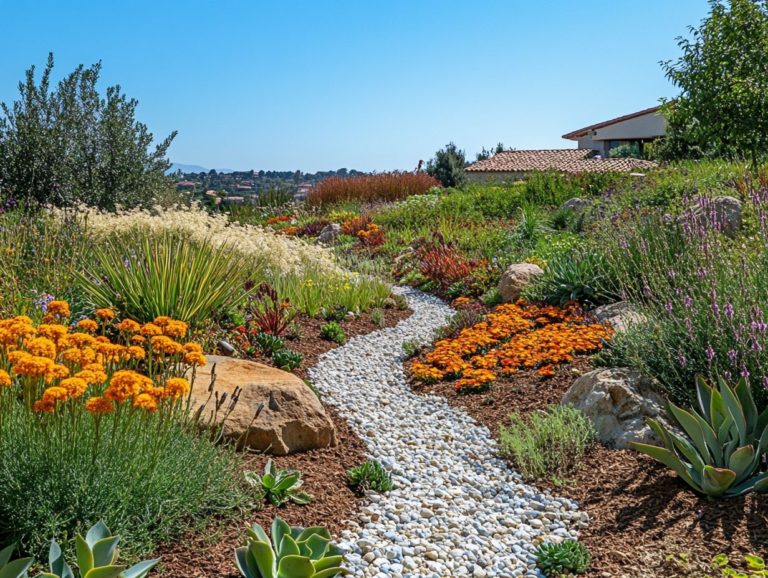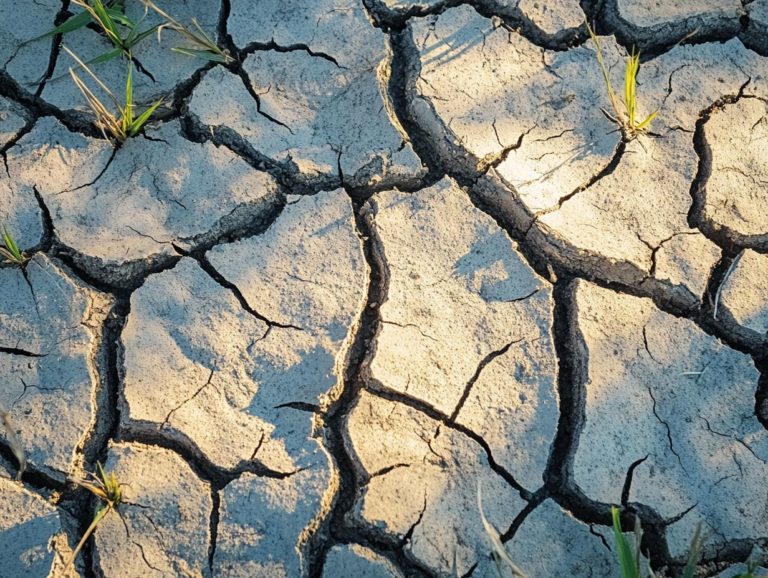The Future of Drought-Resistant Landscaping
As water scarcity becomes an increasingly pressing concern, drought-resistant landscaping presents a sustainable and practical solution for both your home and your community.
This article delves into the myriad benefits of adopting drought-resistant practices, highlighting everything from financial savings to significant environmental advantages.
You’ll discover a variety of plant options, including native species and succulents, along with essential design tips to help you create a resilient landscape.
We will tackle common challenges and offer effective solutions to ensure your outdoor space thrives, even in dry conditions.
Embark on this journey toward a greener, water-efficient future!
Contents
- Key Takeaways:
- What is it and Why is it Important?
- Benefits of Drought-Resistant Landscaping
- Types of Drought-Resistant Plants
- Designing a Drought-Resistant Landscape
- Implementing Drought-Resistant Practices
- Challenges and Solutions for Drought-Resistant Landscaping
- Frequently Asked Questions
- What is drought-resistant landscaping and why is it important?
- How does drought-resistant landscaping benefit the environment?
- What plants need less water?
- Can drought-resistant landscaping be visually appealing?
- What are some techniques used in drought-resistant landscaping?
- Is drought-resistant landscaping cost-effective?
Key Takeaways:

- Drought-resistant landscaping saves money and helps the environment.
- Native plants and succulents are excellent options for creating a drought-resistant landscape.
- To successfully design a drought-resistant landscape, consider water conservation techniques and efficient watering systems that use technology to save water.
What is it and Why is it Important?
Drought-resistant landscaping is not just a trend; it’s an essential practice that enhances the aesthetic appeal of both residential and commercial properties while playing a crucial role in water conservation and sustainability. Understanding the impact of drought on landscaping choices can further highlight its importance.
In areas increasingly affected by drought, adopting these techniques is vital for preserving precious water resources and minimizing maintenance costs.
By embracing strategies like using native plants and implementing efficient watering systems, you can significantly impact your environment while effectively managing your landscaping needs.
Benefits of Drought-Resistant Landscaping
The benefits of drought-resistant landscaping are numerous, including the incorporation of water features in drought-tolerant landscapes, which offer substantial environmental and financial advantages for homeowners and property managers alike.
By choosing water-efficient plants and embracing sustainable garden design practices, you can reduce your environmental footprint while lowering maintenance costs in the long run.
Incorporating organic mulch and drought-tolerant species enhances soil moisture retention and fosters a vibrant landscape.
Environmental and Financial Benefits
Drought-resistant landscaping provides a range of environmental and financial advantages that can elevate your property’s sustainability. By adopting these strategies and staying informed about emerging trends in drought-resistant plants, you enjoy enhanced water efficiency and reduced maintenance costs.
Incorporating native and drought-tolerant plants allows you to create a vibrant landscape that requires less water, conserving this vital resource. Studies show that native landscaping can cut irrigation costs by up to 50%.
These environmentally conscious designs encourage biodiversity, attracting beneficial wildlife, such as pollinators, essential for thriving ecosystems. Implementing sustainable practices like mulching and rainwater harvesting minimizes soil erosion and enhances drainage.
Embracing these methods not only reduces long-term upkeep expenses but also cultivates a healthier environment, creating a win-win scenario for you and the planet.
Types of Drought-Resistant Plants

You have the opportunity to curate a breathtaking and sustainable landscape by choosing a diverse array of drought-resistant plants. Opting for native and drought-tolerant species enhances environmental resilience and elevates your garden’s aesthetic allure.
In regions like Florida, consider selecting species such as:
- Asclepias tuberosa
- Agastache foeniculum
- Rosa virginiana
These choices will ensure your garden remains vibrant in low-water conditions, all while offering a welcome habitat for local wildlife.
Start your journey to a water-efficient garden today!
Native Plants and Succulents
Native plants and succulents offer excellent options for drought-resistant landscaping, especially in regions like Florida, where the climate poses unique challenges for traditional gardening. Varieties such as black-eyed Susan and CitraBlue conserve water and require minimal maintenance, making them ideal for homeowners and commercial properties.
These tough plants thrive in our area, fostering biodiversity and supporting local wildlife by providing essential food and habitat. These plants are vital for a healthy ecosystem; they stabilize soil, reduce erosion, and protect waterways from runoff.
Consider other popular options like the vibrant coral honeysuckle and the steadfast prickly pear cactus. These enhance the beauty of your landscape and contribute significantly to local ecosystems. Embracing native flora and succulents makes a positive impact on both your garden and the environment.
Designing a Drought-Resistant Landscape
Designing a drought-resistant landscape requires careful planning and innovative landscaping techniques that focus on water conservation and aesthetic beauty. By engaging in thoughtful garden design and integrating efficient irrigation systems, you can craft a beautiful garden that thrives even in dry conditions, showcasing the splendor of nature. To learn more about this, explore future trends in drought gardening.
Employing practices such as mulching retains soil moisture and enhances your landscape, ensuring it remains vibrant and resilient.
Factors to Consider and Tips for Success
When designing a drought-resistant landscape, several critical factors contribute to success, from selecting the right plants to implementing efficient irrigation systems. One key strategy is using native plants in drought landscapes. Understanding these basics and applying effective landscaping techniques allows you to create a sustainable outdoor space that flourishes in water-scarce conditions.
Climate greatly influences which plants thrive in your landscape, as some species show resilience to heat and arid environments. Understanding your soil type is also crucial sandy soils drain quickly, while clay retains moisture, both affecting plant health and irrigation needs. Opting for drought-tolerant varieties that fit your local ecosystem fosters a flourishing environment with minimal water use.
Implementing drip irrigation systems, a way to water plants directly at their roots, conserves water effectively. Adding mulch retains soil moisture and creates an ideal habitat for your greenery. Regular maintenance, like thoughtful pruning and occasional fertilization, further enhances the resilience and longevity of your landscape, ensuring it remains a thriving oasis regardless of the weather.
Implementing Drought-Resistant Practices

Implementing drought-resistant practices is crucial for promoting water conservation and ensuring the longevity of a truly sustainable landscape.
By embracing advanced irrigation systems like drip irrigation and smart technologies, along with features such as rain gardens and bioswales, you can enhance water efficiency and lessen reliance on traditional watering methods.
This approach benefits your property and contributes to a healthier environment. Act now to improve your landscape and protect our precious water resources!
Water Conservation Techniques and Irrigation Systems
Water conservation techniques, like drip irrigation and smart irrigation systems, are essential for effective drought-resistant landscaping. These methods help you optimize water usage and reduce maintenance costs, allowing you to cultivate a sustainable landscape with ease.
Take drip irrigation, for example. It uses a system of small pipes and dripping nozzles to deliver water directly to the roots of your plants, minimizing evaporation and runoff. This targeted approach conserves water while enhancing plant health and growth, making your garden thrive.
Smart irrigation systems use technology to automatically adjust watering schedules based on real-time weather conditions and soil moisture levels. This ensures resources are used efficiently, allowing you to relax while your garden gets precisely what it needs.
By integrating these systems, imagine slashing your water bills while creating a lush garden! You ll also drastically reduce the frequency of manual maintenance, leading to long-term savings on upkeep. Embracing these sustainable solutions fosters a healthier ecosystem and contributes to vital water conservation efforts. You’ll be making a real difference while enjoying a flourishing landscape.
Challenges and Solutions for Drought-Resistant Landscaping
Drought-resistant landscaping offers a wealth of benefits, and understanding the importance of drought-resistant plants in landscaping can help you navigate the unique challenges to create a flourishing outdoor space.
Issues like maintaining soil moisture and preventing erosion can pose significant hurdles to your efforts. Fortunately, effective solutions can help you overcome these obstacles and ensure the success of your landscaping endeavors.
Overcoming Obstacles and Maintaining a Drought-Resistant Landscape
Overcoming obstacles in drought-resistant landscaping is essential for maintaining a vibrant and sustainable outdoor environment. By paying close attention to factors such as soil moisture retention and effective erosion control, you can ensure your landscapes flourish even under challenging conditions. Considering the top 10 drought-resistant plants for landscaping can also enhance your efforts.
To achieve this, consider incorporating organic mulch to reduce evaporation and enhance moisture retention in the soil. Selecting native plants well-suited to your local climate can significantly decrease the need for additional watering while promoting biodiversity.
Installing permeable pathways and using contouring techniques will assist in redirecting rainwater and minimizing soil erosion, which often threatens the integrity of a drought-resistant landscape. By actively managing these elements, you create resilient outdoor spaces that can thrive even as water resources become scarcer.
Frequently Asked Questions

What is drought-resistant landscaping and why is it important?
Drought-resistant landscaping is a method of gardening and landscaping that uses plants and techniques requiring minimal water. It conserves water, helps prevent droughts, and saves money on water bills.
How does drought-resistant landscaping benefit the environment?
Drought-resistant landscaping benefits the environment by reducing water usage, conserving water resources, preventing soil erosion, and supporting biodiversity by providing habitats for native plants and animals.
What plants need less water?
Drought-resistant plants have adapted to thrive in dry conditions. Examples include:
- Succulents
- Cacti
- Lavender
- Rosemary
- Ornamental grasses
Native plants specific to your region are also often considered drought-resistant.
Can drought-resistant landscaping be visually appealing?
Yes, drought-resistant landscaping can be visually appealing. There are a variety of plants and design options available that can create a beautiful and sustainable landscape. Incorporating different textures, heights, and colors adds interest and beauty to a drought-resistant garden, especially when considering the role of xeriscaping in drought areas.
What are some techniques used in drought-resistant landscaping?
Techniques for drought-resistant landscaping include mulching, drip irrigation, and xeriscaping. Mulching retains moisture in the soil. Drip irrigation delivers water directly to plant roots.
Xeriscaping means using plants that need very little water and applying design principles that reduce water use.
Is drought-resistant landscaping cost-effective?
Absolutely! Drought-resistant landscaping saves you money in the long run.
Initial costs may be higher due to purchasing new plants and materials. However, you’ll save on water bills and maintenance costs over time.
This approach also adds value to your property and reduces the need for frequent replacements or repairs.






